Wearable Sensing’s wireless DSI-VR300 is the leading dry electrode EEG system in terms of signal quality and comfort. The DSI-VR300 takes on average less than 1 minute to set up, making it the ideal solution for scientists in need of a simple, easy to use, EEG system. Our patented sensor technology not only delivers uncompromised signal quality but also enables our system to be virtually immune against motion and electrical artifacts. As a result, the DSI-VR300 can be utilized in virtual or augmented reality, while also allowing researchers to take their experiments out of the lab, and into the real world.
The VR300 has sensor locations in the back of the head, and therefore optimized for visually evoked potentials like P300 and SSVEP. The VR300 can be used with or without a VR headset
Used around the world by leaders in Research, & Brain-Computer Interfaces
With over 90% correlation to research-grade wet EEG systems, the dry sensor interface (DSI) offers unparalleled quality and performance
Multiple adjustment points and a foam pad lined interior enable the system to be worn for up to 8 hours on any head shape or size
All DSI systems include free, unlimited licenses of DSI-Streamer, our data acquisition software which can record raw data, in .csv and .edf file formats
Faraday cage's, spring-loaded electrodes, and our patented common-mode follower technology, provides near immunity against electrical and motion artifacts
Using 70% isopropyl alcohol and a cleaning brush, the DSI-VR300 only takes a minute to clean, 3 minutes to dry, and can be up and running on the next subject in minutes
All DSI systems include our free C based .dll API, which enables users to pull the raw data directly from the headset, for custom software on Windows, Mac OS, Linux, and ARM
The DSI-VR300 was designed for ultra-rapid setup, taking on average less than 1 minute to don, and works on any type of hair, including long hair, thick hair, afros, and more
DSI headsets have active sensors, amplifiers, digitizers, batteries, onboard storage, and wireless transmission, making them complete, mobile, wearable EEG systems
DSI systems exclusively work with QStates, a machine learning algorithm for cognitive classification on states such as mental workload, engagement, and fatigue
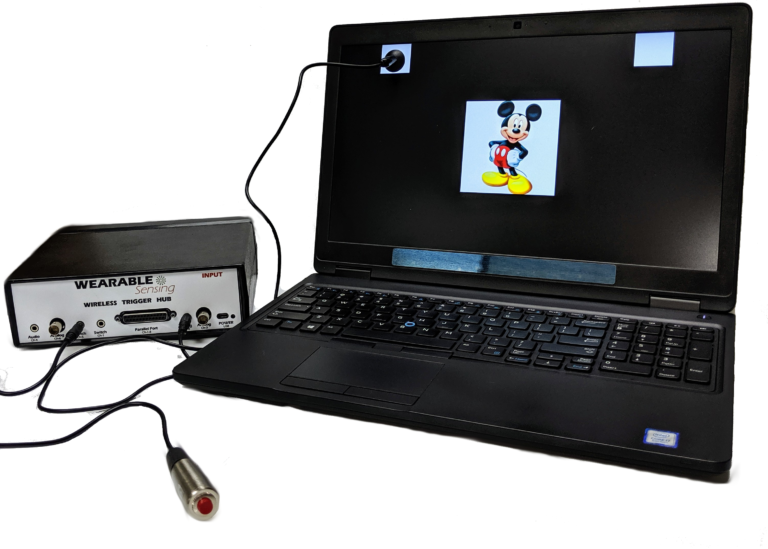
Our Wireless Trigger Hub simplifies the synchronization of DSI headsets with other devices. It features:
An additional benefit of the Trigger Hub design is that it allows synchronization across multiple data sources that are distributed across multiple systems, each of which running at its own clock rate. One such case commonly experienced in EEG experiments involves the synchronization of EEG and eye-tracking measurements, where the inevitable clock drift that arises between two systems during extended measurements creates difficulty in aligning data to events across the two systems.
Locations optimized for:
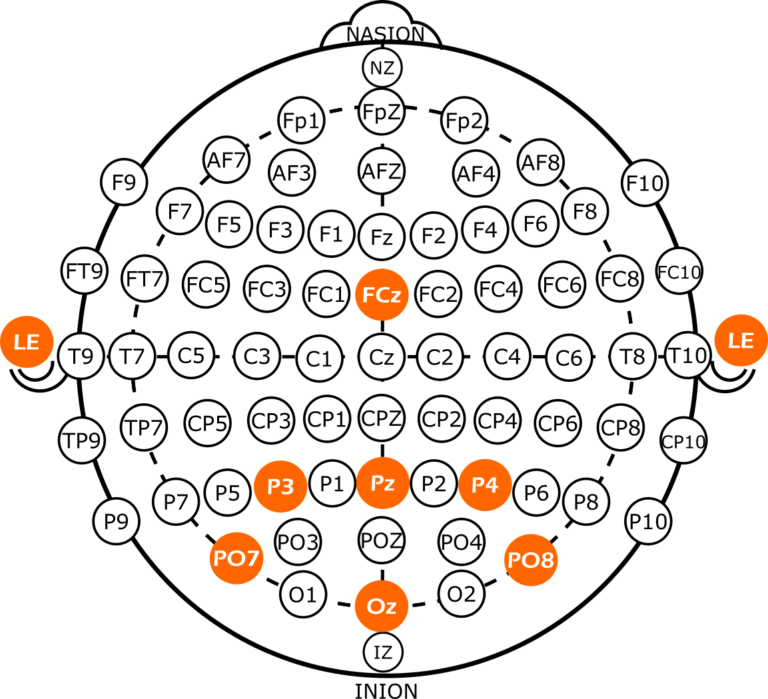
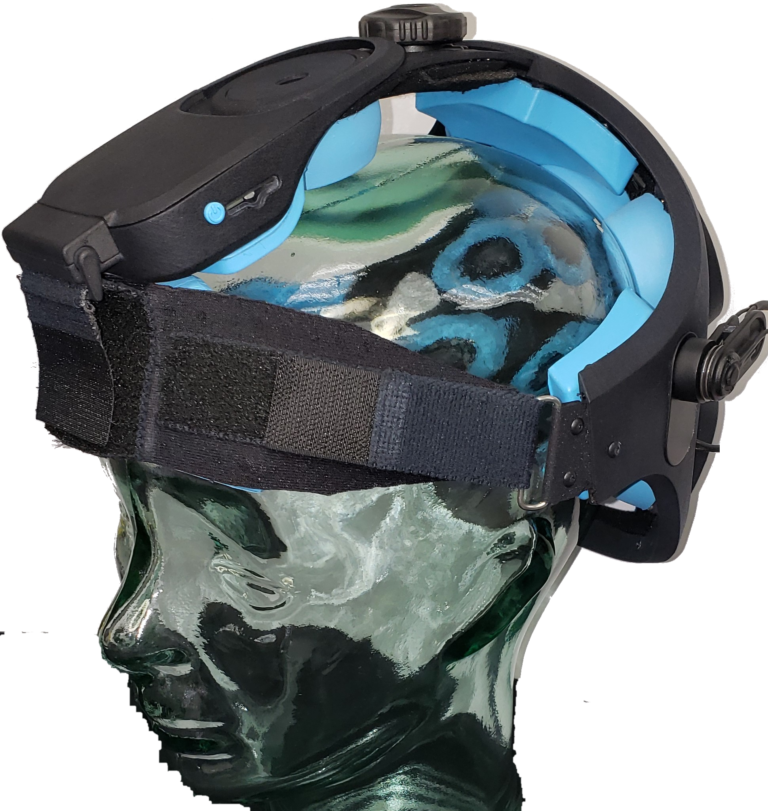
Locations optimized for:
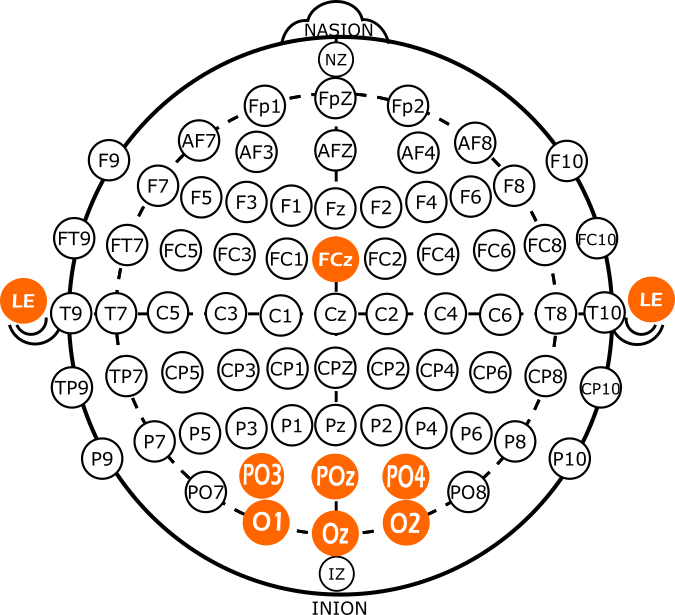
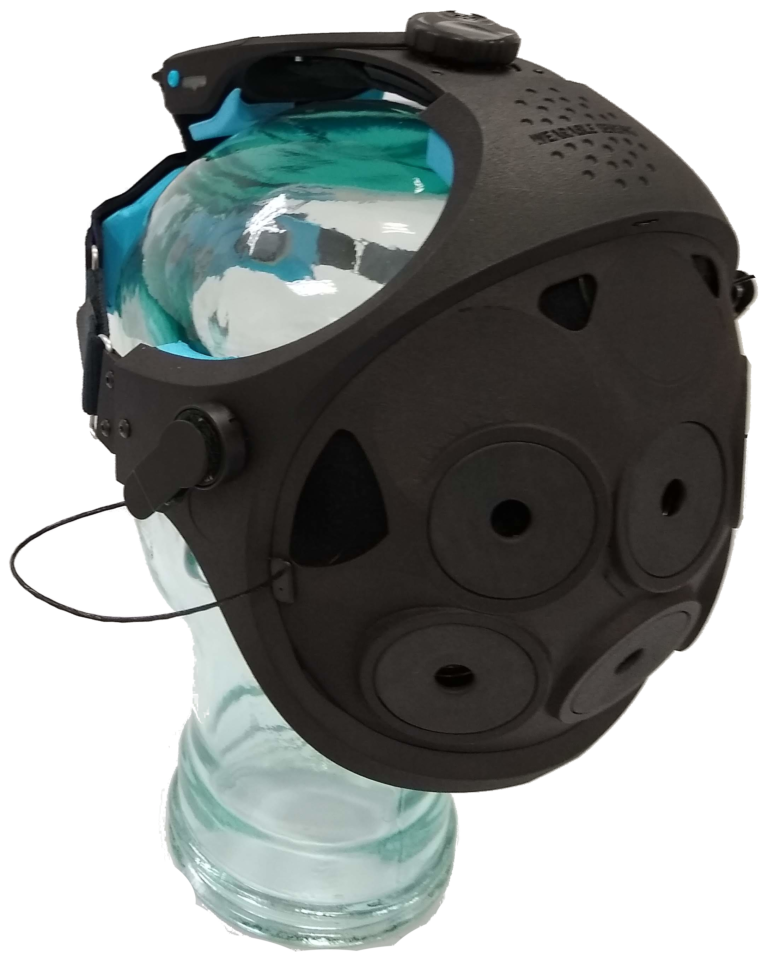
EEG Channels
DSI-VR300: FCz, Pz, P3, P4, PO7, PO8, Oz, Linked Ears
DSI-VRVEP: FCz, POz, PO3, PO4, O1, O2, Oz, Linked Ears
Reference / Ground
Common Mode Follower / A1
Head Size Range
Adult Size: 52cm – 62cm circumference
Sampling Rate
300 Hz (600Hz upgrade available)
Bandwidth
0.003 – 150 Hz
A/D resolution
0.317 μV referred to input
Input Impedance (1Hz)
47 GΩ
CMRR
> 120 dB
Amplifier / Digitizer
16 bits / 7 channels
Wireless
Bluetooth
Wireless Range
10 m
Run-time
> 12 Hours
Data Acquisition
Real time, evoked potentials
Signal Quality Monitoring
Continuous impedance, Baseline offset, Noise (1-50 Hz)
Data Type
Raw and Filtered Data available
File Type
.CSV and .EDF
Data Output Streaming
TCP/IP socket, API (C Based), LSL
Cognitive State Classification
Brain Computer Interface
SSVEP BCI Algorithms; BCI2000; OpenViBE; PsychoPy; BCILab
Data Integration / Analysis
CAPTIV; Lab Streaming Layer; NeuroPype; BrainStorm; NeuroVIS
Presentation
Presentation; E-Prime
Calleja, Daniel; Buhagiar, Marie; Porter, Chris; Camilleri, Tracey; Camilleri, Kenneth
Advancing Boggle-Taking BCI Web-Browsing Out of the Lab Conference
Proceedings of the 16th Biannual Conference of the Italian SIGCHI Chapter, 2025.
@conference{calleja2025advancingb,
title = {Advancing Boggle-Taking BCI Web-Browsing Out of the Lab},
author = {Daniel Calleja and Marie Buhagiar and Chris Porter and Tracey Camilleri and Kenneth Camilleri},
doi = {https://doi.org/10.1145/3750069.3757721},
year = {2025},
date = {2025-10-14},
urldate = {2025-01-01},
booktitle = {Proceedings of the 16th Biannual Conference of the Italian SIGCHI Chapter},
pages = {1–2},
abstract = {Boggle is an open-source, brain-native web browser designed for individuals living with highly restrictive motor impairments. Leveraging Steady-State Visual Evoked Potentials (SSVEP) and in-browser stimuli generation, Boggle enables users to navigate and interact with the web using only their brain signals. This interactive demo presents our newly developed architecture that is meant to enable people to use this BCI-browser outside of a lab environment. Along with an embedded signal acquisition and classification pipeline, Boggle also ships with a novel, customisable and empirically verified SSVEP stimulus generator that was developed entirely using native web technologies. As part of BrainWeb, a project funded by the University of Malta Research Excellence Fund, Boggle is also designed to integrate with low-cost and commercially available electroencephalogram (EEG) headsets, lowering barriers to entry while balancing quality in use. This interactive experience will allow attendees to explore BCI-based web browsing and gain insight into its key aspects and challenges.
},
keywords = {},
pubstate = {published},
tppubtype = {conference}
}
Klee, D; Memmott, T; Oken, B
Autonomic Activation, Mental Effort, and Fatigue While Using Non-Implantable RSVP and Matrix cBCIs Conference
11th International Brain-Computer Interface Meeting 2025 2025.
@conference{kleeautonomic,
title = {Autonomic Activation, Mental Effort, and Fatigue While Using Non-Implantable RSVP and Matrix cBCIs},
author = {D Klee and T Memmott and B Oken},
url = {https://diglib.tugraz.at/download.php?id=6855150d3d366&location=browse},
doi = {10.3217/978-3-99161-050-2-074},
year = {2025},
date = {2025-06-02},
organization = {11th International Brain-Computer Interface Meeting 2025},
abstract = {Non-implantable communication BCI (cBCI) systems may offer substantial benefits to individuals with communication impairments. However, prior research has suggested that sustained use of these systems may be impeded by factors such as fatigue, sleepiness, and boredom [1]. Relatedly, there is little extant data to directly compare differences in mental effort or autonomic activation between two common P300-based cBCI paradigms: Rapid Serial Visual Presentation (RSVP) and Matrix. The present study compared measurements of autonomic activation during both RSVP and Matrix tasks, as well as self reported mental effort, fatigue, sleepiness, and boredom. We predicted elevated autonomic and self-report levels during RSVP as compared to Matrix, and also increases in these measures over time.},
keywords = {},
pubstate = {published},
tppubtype = {conference}
}
Chiossi, Francesco; Ou, Changkun; Mayer, Sven
2024.
@conference{chiossi2024optimizing,
title = {Optimizing Visual Complexity for Physiologically-Adaptive VR Systems: Evaluating a Multimodal Dataset using EDA, ECG and EEG Features},
author = {Francesco Chiossi and Changkun Ou and Sven Mayer},
url = {https://sven-mayer.com/wp-content/uploads/2024/04/chiossi2024optimizing.pdf},
year = {2024},
date = {2024-06-03},
urldate = {2024-01-01},
abstract = {Physiologically-adaptive Virtual Reality systems dynamically adjust virtual content based on users’ physiological signals to enhance interaction and achieve specific goals. However, as different users’ cognitive states may underlie multivariate physiological patterns, adaptive systems necessitate a multimodal evaluation to investigate the relationship between input physiological features and target states for efficient user modeling. Here, we investigated a multimodal dataset (EEG, ECG, and EDA) while interacting with two different adaptive systems adjusting the environmental visual complexity based on EDA. Increased visual complexity led to increased alpha power and alpha-theta ratio, reflecting increased mental fatigue and workload. At the same time, EDA exhibited distinct dynamics with increased tonic and phasic components. Integrating multimodal physiological measures for adaptation evaluation enlarges our understanding of the impact of system adaptation on users’ physiology and allows us to account for it and improve adaptive system design and optimization algorithms.},
keywords = {},
pubstate = {published},
tppubtype = {conference}
}
Klee, Daniel; Memmott, Tab; Oken, Barry
In: Signals, vol. 5, no. 1, pp. 18–39, 2024.
@article{klee2024effect,
title = {The Effect of Jittered Stimulus Onset Interval on Electrophysiological Markers of Attention in a Brain–Computer Interface Rapid Serial Visual Presentation Paradigm},
author = {Daniel Klee and Tab Memmott and Barry Oken},
doi = {https://doi.org/10.3390/signals5010002},
year = {2024},
date = {2024-01-09},
urldate = {2024-01-01},
journal = {Signals},
volume = {5},
number = {1},
pages = {18–39},
publisher = {MDPI},
abstract = {Brain responses to discrete stimuli are modulated when multiple stimuli are presented in sequence. These alterations are especially pronounced when the time course of an evoked response overlaps with responses to subsequent stimuli, such as in a rapid serial visual presentation (RSVP) paradigm used to control a brain–computer interface (BCI). The present study explored whether the measurement or classification of select brain responses during RSVP would improve through application of an established technique for dealing with overlapping stimulus presentations, known as irregular or “jittered” stimulus onset interval (SOI). EEG data were collected from 24 healthy adult participants across multiple rounds of RSVP calibration and copy phrase tasks with varying degrees of SOI jitter. Analyses measured three separate brain signals sensitive to attention: N200, P300, and occipitoparietal alpha attenuation. Presentation jitter visibly reduced intrusion of the SSVEP, but in general, it did not positively or negatively affect attention effects, classification, or system performance. Though it remains unclear whether stimulus overlap is detrimental to BCI performance overall, the present study demonstrates that single-trial classification approaches may be resilient to rhythmic intrusions like SSVEP that appear in the averaged EEG.},
keywords = {},
pubstate = {published},
tppubtype = {article}
}
Chiossi, Francesco; Turgut, Yagiz; Welsch, Robin; Mayer, Sven
Adapting Visual Complexity Based on Electrodermal Activity Improves Working Memory Performance in Virtual Reality Journal Article
In: Proc. ACM Hum.-Comput. Interact, vol. 7, 2023.
@article{chiossi2023adapting,
title = {Adapting Visual Complexity Based on Electrodermal Activity Improves Working Memory Performance in Virtual Reality},
author = {Francesco Chiossi and Yagiz Turgut and Robin Welsch and Sven Mayer},
url = {https://www.researchgate.net/profile/Francesco-Chiossi/publication/371539688_Adapting_Visual_Complexity_Based_on_Electrodermal_Activity_Improves_Working_Memory_Performance_in_Virtual_Reality/links/648983619bc5e436682f0b97/Adapting-Visual-Complexity-Based-on-Electrodermal-Activity-Improves-Working-Memory-Performance-in-Virtual-Reality.pdf},
year = {2023},
date = {2023-09-02},
urldate = {2023-01-01},
journal = {Proc. ACM Hum.-Comput. Interact},
volume = {7},
abstract = {Biocybernetic loops encompass users’ state detection and system adaptation based on physiological signals. Current adaptive systems limit the adaptation to task features such as task difficulty or multitasking demands. However, virtual reality allows the manipulation of task-irrelevant elements in the environment. We present a physiologically adaptive system that adjusts the virtual environment based on physiological arousal, i.e., electrodermal activity. We conducted a user study with our adaptive system in social virtual reality to verify improved performance. Here, participants completed an n back task, and we adapted the visual complexity of the environment by changing the number of non-player characters. Our results show that an adaptive virtual reality can control users’ comfort, performance, and workload by adapting the visual complexity based on physiological arousal. Thus, our physiologically adaptive system improves task performance and perceived workload. Finally, we embed our findings in physiological computing and discuss applications in various scenarios},
keywords = {},
pubstate = {published},
tppubtype = {article}
}
Klee, Daniel; Memmott, Tab; Smedemark-Margulies, Niklas; Celik, Basak; Erdogmus, Deniz; Oken, Barry S
Target-Related Alpha Attenuation in a Brain-Computer Interface Rapid Serial Visual Presentation Calibration Journal Article
In: Frontiers in Human Neuroscience, vol. 16, 2022.
@article{klee2022target,
title = {Target-Related Alpha Attenuation in a Brain-Computer Interface Rapid Serial Visual Presentation Calibration},
author = {Daniel Klee and Tab Memmott and Niklas Smedemark-Margulies and Basak Celik and Deniz Erdogmus and Barry S Oken},
doi = {10.3389/fnhum.2022.882557},
year = {2022},
date = {2022-04-21},
urldate = {2022-01-01},
journal = {Frontiers in Human Neuroscience},
volume = {16},
publisher = {Frontiers Media SA},
abstract = {This study evaluated the feasibility of using occipitoparietal alpha activity to drive target/non-target classification in a brain-computer interface (BCI) for communication. EEG data were collected from 12 participants who completed BCI Rapid Serial Visual Presentation (RSVP) calibrations at two different presentation rates: 1 and 4 Hz. Attention-related changes in posterior alpha activity were compared to two event-related potentials (ERPs): N200 and P300. Machine learning approaches evaluated target/non-target classification accuracy using alpha activity. Results indicated significant alpha attenuation following target letters at both 1 and 4 Hz presentation rates, though this effect was significantly reduced in the 4 Hz condition. Target-related alpha attenuation was not correlated with coincident N200 or P300 target effects. Classification using posterior alpha activity was above chance and benefitted from individualized tuning procedures. These findings suggest that target-related posterior alpha attenuation is detectable in a BCI RSVP calibration and that this signal could be leveraged in machine learning algorithms used for RSVP or comparable attention-based BCI paradigms.},
keywords = {},
pubstate = {published},
tppubtype = {article}
}
McLaughlin, Deirdre; Klee, Daniel; Memmott, Tab; Peters, Betts; Wiedrick, Jack; Fried-Oken, Melanie; Oken, Barry
Methodology and feasibility of neurofeedback to improve visual attention to letters in mild Alzheimer's disease Journal Article
In: Human-Computer Interaction, 2021.
@article{mclaughlin2021methodology,
title = {Methodology and feasibility of neurofeedback to improve visual attention to letters in mild Alzheimer's disease},
author = {Deirdre McLaughlin and Daniel Klee and Tab Memmott and Betts Peters and Jack Wiedrick and Melanie Fried-Oken and Barry Oken},
url = {https://arxiv.org/abs/2111.12153},
year = {2021},
date = {2021-11-23},
journal = {Human-Computer Interaction},
abstract = {Brain computer interfaces systems are controlled by users through neurophysiological input for a variety of applications including communication, environmental control, motor rehabilitation, and cognitive training. Although individuals with severe speech and physical impairment are the primary users of this technology, BCIs have emerged as a potential tool for broader populations, especially with regards to delivering cognitive training or interventions with neurofeedback. The goal of this study was to investigate the feasibility of using a BCI system with neurofeedback as an intervention for people with mild Alzheimer's disease. The study focused on visual attention and language since ad is often associated with functional impairments in language and reading. The study enrolled five adults with mild ad in a nine to thirteen week BCI EEG based neurofeedback intervention to improve attention and reading skills. Two participants completed intervention entirely. The remaining three participants could not complete the intervention phase because of restrictions related to covid. Pre and post assessment measures were used to assess reliability of outcome measures and generalization of treatment to functional reading, processing speed, attention, and working memory skills. Participants demonstrated steady improvement in most cognitive measures across experimental phases, although there was not a significant effect of NFB on most measures of attention. One subject demonstrated significantly significant improvement in letter cancellation during NFB. All participants with mild AD learned to operate a BCI system with training. Results have broad implications for the design and use of bci systems for participants with cognitive impairment. Preliminary evidence justifies implementing NFB-based cognitive measures in AD.},
keywords = {},
pubstate = {published},
tppubtype = {article}
}
Kim, Soram; Lee, Seungyun; Kang, Hyunsuk; Kim, Sion; Ahn, Minkyu
P300 Brain--Computer Interface-Based Drone Control in Virtual and Augmented Reality Journal Article
In: Sensors, vol. 21, no. 17, pp. 5765, 2021.
@article{kim2021p300,
title = {P300 Brain--Computer Interface-Based Drone Control in Virtual and Augmented Reality},
author = {Soram Kim and Seungyun Lee and Hyunsuk Kang and Sion Kim and Minkyu Ahn},
doi = {https://doi.org/10.3390/s21175765},
year = {2021},
date = {2021-08-27},
journal = {Sensors},
volume = {21},
number = {17},
pages = {5765},
publisher = {Multidisciplinary Digital Publishing Institute},
abstract = {Since the emergence of head-mounted displays (HMDs), researchers have attempted to introduce virtual and augmented reality (VR, AR) in brain–computer interface (BCI) studies. However, there is a lack of studies that incorporate both AR and VR to compare the performance in the two environments. Therefore, it is necessary to develop a BCI application that can be used in both VR and AR to allow BCI performance to be compared in the two environments. In this study, we developed an opensource-based drone control application using P300-based BCI, which can be used in both VR and AR. Twenty healthy subjects participated in the experiment with this application. They were asked to control the drone in two environments and filled out questionnaires before and after the experiment. We found no significant (p > 0.05) difference in online performance (classification accuracy and amplitude/latency of P300 component) and user experience (satisfaction about time length, program, environment, interest, difficulty, immersion, and feeling of self-control) between VR and AR. This indicates that the P300 BCI paradigm is relatively reliable and may work well in various situations},
keywords = {},
pubstate = {published},
tppubtype = {article}
}
Pereira, Arnaldo; Padden, Dereck; Jantz, Jay; Lin, Kate; Alcaide-Aguirre, Ramses
Cross-Subject EEG Event-Related Potential Classification for Brain-Computer Interfaces Using Residual Networks Journal Article
In: 2018.
@article{pereira2018cross,
title = {Cross-Subject EEG Event-Related Potential Classification for Brain-Computer Interfaces Using Residual Networks},
author = {Arnaldo Pereira and Dereck Padden and Jay Jantz and Kate Lin and Ramses Alcaide-Aguirre},
doi = {10.13140/RG.2.2.16257.10086},
year = {2018},
date = {2018-09-20},
urldate = {2018-01-01},
abstract = {EEG event-related potentials, and the P300 signal in
particular, are promising modalities for brain-computer interfaces (BCI). But the nonstationarity of EEG signals and
their differences across individuals have made it difficult to
implement classifiers that can determine user intent without having to be retrained or calibrated for each new user
and sometimes even each session. This is a major impediment to the development of consumer BCI. Recently, the
EEG BCI literature has begun to apply convolutional neural
networks (CNNs) for classification, but experiments have
largely been limited to training and testing on single subjects. In this paper, we report a study in which EEG data
were recorded from 66 subjects in a visual oddball task
in virtual reality. Using wide residual networks (WideResNets), we obtain state-of-the-art performance on a test set
composed of data from all 66 subjects together. Additionally, a minimal preprocessing stream to convert EEG data
into square images for CNN input while adding regularization is presented and shown to be viable. This study also
provides some guidance on network architecture parameters based on experiments with different models. Our results show that it may possible with enough data to train
a classifier for EEG-based BCIs that can generalize across
individuals without the need for individual training or calibration.
},
keywords = {},
pubstate = {published},
tppubtype = {article}
}